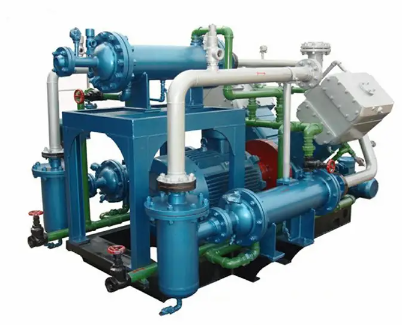Mastering the Art of Piston Compressor Design

Hey there, fellow engineering enthusiasts and curious minds! If you’re keen on exploring the fascinating world of piston compressor design, you’ve come to the right place. In this article, I’ll be your friendly guide on a journey through the ins and outs of piston compressor design. We’ll uncover the key components, the principles behind their operation, and how various design elements contribute to the efficiency and functionality of these mechanical marvels. So, let’s dive right in and demystify the art of piston compressor design!
Understanding Piston Compressors: A Brief Overview
Before we delve into the design details, let’s establish a foundational understanding of what piston compressors are and how they work.
What Is a Piston Compressor?
A piston compressor, also known as a reciprocating compressor, is a type of mechanical device used to compress gases. It operates on the principle of using one or more pistons within cylinders to compress gas by reducing its volume. These compressors are commonly found in various applications, from automotive air conditioning systems to industrial manufacturing processes.
The Piston’s Role
At the heart of a piston compressor lies the piston itself. This crucial component moves back and forth within a cylinder, creating changes in volume that lead to the compression of gas. Understanding the piston’s role is essential to grasp the fundamentals of piston compressor design.
The Art of Piston Compressor Design
Now that we have the basics in place, let’s explore the various design elements that make piston compressors tick.
1. Cylinder Design
Cylinder Configuration
The number and arrangement of cylinders in a piston compressor significantly impact its performance. Compressors can have single-cylinder or multi-cylinder designs, such as single-stage or two-stage compressors. Multi-cylinder compressors offer better efficiency and higher compression ratios.
Cylinder Material
The material used for the cylinder affects its durability and resistance to wear. Common materials include cast iron, aluminum, and steel, each with its own set of advantages and limitations.
2. Piston Design
Piston Type
Piston compressors can have different types of pistons, such as single-acting or double-acting. Single-acting pistons compress gas on one side of the piston, while double-acting pistons compress gas on both sides, making them more efficient.
Piston Rings
Piston rings play a crucial role in maintaining a proper seal between the piston and cylinder walls. They prevent gas from leaking past the piston and ensure efficient compression.
3. Valves
Inlet and Outlet Valves
Valves, including inlet and outlet valves, control the flow of gas into and out of the cylinder. Proper valve design is essential for efficient compression and release of compressed gas.
4. Lubrication System
A well-designed lubrication system ensures that moving parts, such as the piston and crankshaft, remain adequately lubricated. Lubrication reduces friction, heat generation, and wear, prolonging the compressor’s life.
5. Cooling Mechanism
Efficient cooling is critical to prevent overheating during compression. Piston compressors may use air or water cooling systems to maintain the desired operating temperature.
6. Drive Mechanism
Piston compressors are typically driven by electric motors or internal combustion engines. The drive mechanism’s design must match the compressor’s power requirements and operational demands.
7. Noise Reduction
Noise reduction is an essential aspect of compressor design, especially in applications where quiet operation is required. Design elements, such as vibration isolation and soundproofing, help reduce noise levels.
FAQs About Piston Compressor Design
Let’s address some common questions about piston compressor design to deepen our understanding.
Q1: What is the advantage of a two-stage piston compressor?
A: A two-stage piston compressor has two cylinders and compresses gas in two stages. This design allows it to achieve higher compression ratios, making it suitable for applications that require high-pressure air, such as industrial processes and some automotive applications.
Q2: How do I choose the right cylinder material for a piston compressor?
A: The choice of cylinder material depends on factors like the compressor’s intended use, operating conditions, and budget. Cast iron offers excellent durability, while aluminum is lightweight and corrosion-resistant. Steel combines strength with heat resistance.
Q3: What role do piston rings play in compressor design?
A: Piston rings create a seal between the piston and cylinder walls, preventing gas from leaking past the piston. They are crucial for maintaining compression efficiency and preventing energy losses.
Q4: Are there eco-friendly design options for piston compressors?
A: Yes, eco-friendly design options include incorporating energy-efficient components, optimizing compression ratios, and using environmentally friendly refrigerants in air conditioning compressors.
Q5: How can I reduce noise in a piston compressor?
A: Noise reduction in piston compressors can be achieved through design modifications, including vibration isolation, soundproofing enclosures, and mufflers. Proper maintenance, such as keeping moving parts well-lubricated, can also reduce noise.
Conclusion
In conclusion, piston compressor design is a fascinating blend of mechanical engineering principles and practical considerations. Understanding the various design elements, from cylinder configuration to cooling mechanisms, is essential for creating efficient and reliable compressors that serve a wide range of applications.
For top-notch piston compressors and related products that embody the art of design, CN Compressors offers a selection to explore. You can find more information about their products here and here. So, whether you’re in manufacturing, automotive, or any other industry that relies on compressed air, a well-designed piston compressor is your trusty ally in achieving efficient and consistent operations. Happy compressing!
